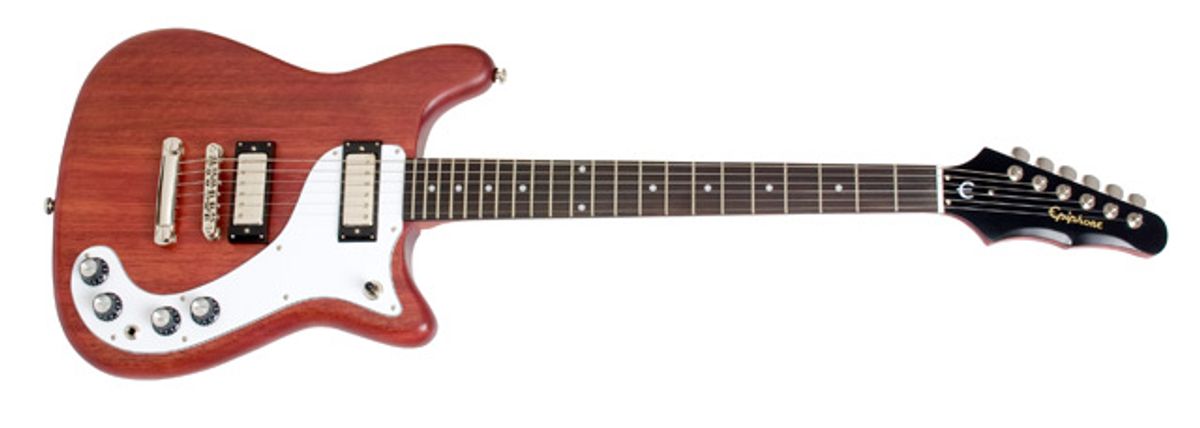
This vintage-vibey reissue is worth a try if you''re looking to add a rhythm guitar workhorse to your stable.
Radios Appear
The first thing that popped into my head after flipping open the case of the Worn 1966 Wilshire was the image of the Australian band Radio Birdman’s debut LP Radios Appear(Trafalgar, 1977). Front and center was the guitar player, coolly holding an Epiphone Wilshire. Almost immediately, songs came pouring forth from my memory: “Man with Golden Helmet,” “Descent into the Maelstrom,” and the underground punk classic, “Aloha Steve and Danno,” with the obligatory searing rendition of the Hawaii 5-0 theme appearing as the middle eighth. It was certainly a mainstay in my high-school-era Oldsmobile Omega (albeit in its portable 8 track form.) Upon further research, I learned that Radio Birdman’s lead guitarist Deniz Tek was actually playing an Epiphone Crestwood Deluxe with three pickups, but pickup complement aside it’s virtually the same guitar, and certainly has the same vibe.
When In Doubt, Go Mod
As with the original, the worn ‘66 Wilshire is a streamlined, minimalist, mod axe. One could imagine The Move’s Trevor Burton or The Creation’s Eddie Phillips sawing away on this inexpensive axe at The Marquee Club during the heady days of Swinging London. The asymmetrical double cutaway body has the look of a cooler Stratocaster or SG. I totally dig the six-on-a-side “batwing” headstock and have always preferred that setup for easier live tuning. It features a functional, unadorned dot-inlayed rosewood fretboard and an aged cherry-red finish. It comes equipped with two mini-humbucker pickups, two Volume and two Tone pots, a three-way toggle pickup selector, a LockTone Tune-O-Matic bridge and stopbar tailpiece. The unobtrusive pickguard adds to the austere look of this utilitarian guitar. Apart from the gold peghead logo, there are no decorative aspects to this pure rock-‘n’-roll machine.
Working Man’s Guitar
With the first strum of the unplugged guitar, you’re greeted with a pleasant ringing tone that exhibits decent sustain. The ‘60s slim-tapered neck is comfortable in the hand, and the ensuing chord changes were made with ease. It has a flat fretboard radius of 14". This neck works great for power chords and tight rhythm jabs, but it may not be the most lead-player-friendly. Try a few pull-offs or bends and you’ll see what I mean—it’s just not that responsive. This could be due to the original setup, and the action could possibly be lowered to an extent to make it more lead-player friendly.
The body of the guitar is not a single piece of Mahogany but several glued together. This still looks great from across the venue, but may take away from the sustain and tone a serious lead player might be looking for at a gig. This is not a shredder’s guitar by any means, but since I wouldn’t use it in that fashion, I don’t really care. This guitar is very lightweight and should get any player through a grinding three-set show without the need for post-gig physical therapy. It does come with a sturdy, contoured hardshell case for banging around in the back of the van.
Garage Rock, Anyone?
So let’s plug this thing in. The amp I chose for the test drive is my trusty and versatile Fender Deluxe Reverb reissue. Set at a clean low volume, the Wilshire delivers a sweet, clear, and accurate tone that could be suitable for a variety of genres. Country, folk-rock, indie-rock, you name it and the Wilshire delivers a broad range of tonal possibilities. As we move into amp cranking mode, the bridge pickup serves up some much-needed raunch. Stinging lead tones materialize, too, with the toggle set in the middle position. The mini-humbuckers don’t bark as much as single-coil pickups, which I typically prefer, but they certainly get the job done. They are surprisingly sensitive for an inexpensive guitar. The neck is joined at the 22nd fret, which makes for easy accessibility all up and down the neck, but it also adds a flexibility that some players may not care for, though it increases the ease of producing feedback. If your gig is a Velvet Underground or Sonic Youth tribute act this could come in handy! In my mind, this guitar would be perfect for old-school garage rock. Think Sonics, Standells, Music Machine, or any one of a thousand Stones-worshipping beat-and-soul combos that popped up across America back in 1966. The Wilshire just has that aura; it looks, feels, and, sounds like a classic workhorse guitar that just about any musician on a budget could afford.
Quest For Tone
Overall, I would have to say that I enjoyed playing this guitar a great deal and would like to own one myself. I already own an Epiphone Casino and an Epiphone SG reissue, and both of these guitars see stage action on a monthly basis. They are light, reliable guitars with good tone and delivery. And when you’re playing a lot of gigs, believe me, you need dependable gear that won’t let you down in the heat of the battle. (Side note: Back in the early ‘90s, I played in an alt-rock band whose other guitarist played Epiphone Wilshires through a 300-watt Ampeg bass head, and that is a whole lot of air being pushed through a 4x12 cabinet, let me tell you.) Make no mistake, this is no milquetoast beginner’s guitar. On the contrary—set to stun, the Wilshire can provide boatloads of tone… along with boatloads of hearing damage.
The Final Mojo
The Epiphone Worn 1966 Wilshire is the epitome of functional design. It’s simple, durable and versatile, yet it’s stylish enough to leap off an album cover—even an obscure one from 1977. Good for both bar gigs and outdoor festivals, the possibilities the Wilshire offers are ample.
Buy if...
you’re a stylish rhythm guitar player on a budget.
Skip if...
you’re a lead player looking for a responsive guitar for fast playing.
Rating...
Street $379 - Epiphone - epiphone.com |
